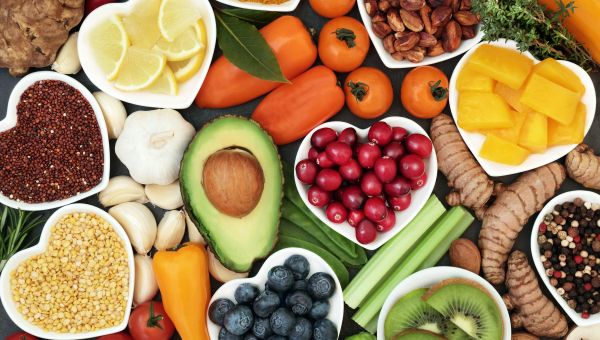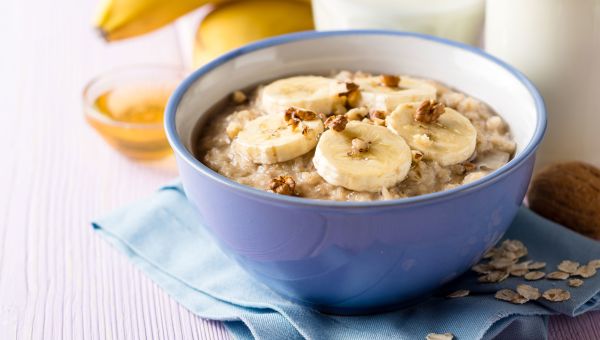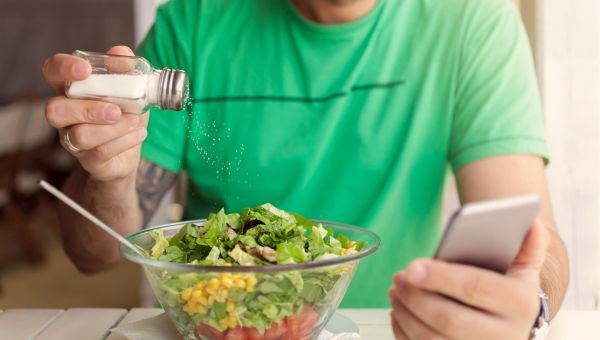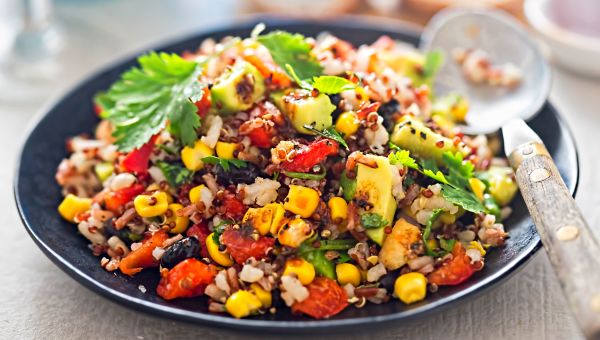What to eat if you have heart failure
Keep your heart strong with these expert-backed nutrition tips.
Updated on September 12, 2023

If you’ve been diagnosed with heart failure, you may assume there’s little you can do to manage your condition. But that’s not true. There’s plenty of changes you can make to your everyday life. Diet is especially key.
If you have heart failure—or even if you don’t—follow these good-for-you nutritional habits.

Eat heart-healthy foods
The American Heart Association (AHA) advises that everyone eat a variety of nutrient-rich foods to support heart health. These include:
- A wide range of fruits and vegetables
- Whole grains, such as those found in whole-grain bread, plain oatmeal, brown rice, or quinoa
- Low-fat dairy
- Fish, unprocessed/ … Show More
The American Heart Association (AHA) advises that everyone eat a variety of nutrient-rich foods to support heart health. These include:
- A wide range of fruits and vegetables
- Whole grains, such as those found in whole-grain bread, plain oatmeal, brown rice, or quinoa
- Low-fat dairy
- Fish, unprocessed/lean chicken, and other lean proteins
- Nuts and legumes like kidney beans, peas, soybeans, and lima beans
- Good-for-you vegetable oils such as canola, corn, olive, and safflower oils
If you have heart failure, your recommended diet may be a little different. Your healthcare provider (HCP) may suggest you try the lower-sodium version of the DASH eating plan, short for Dietary Approaches to Stop Hypertension. DASH has been proven to lower blood pressure and low-density lipoprotein (aka, LDL or “bad” cholesterol). Unlike the regular DASH diet, which caps your sodium intake at 2,300 milligrams (mg) per day, the lower-sodium version limits sodium to 1,500 mg per day. Both approaches are built around food groups that contain blood pressure-lowering nutrients like potassium, magnesium, and fiber.
“It’s not that we want to prevent you from eating what you like,” says Poorna Nalabothu, MD, a heart failure cardiologist in Salt Lake City, Utah. The idea is to make tweaks. “Instead of fried chicken, have grilled chicken with lots of spices. If you like pizza, top with vegetables instead of pepperoni. Rather than desserts with high fructose corn syrup, choose dark chocolate.”
Show Less
A Day of DASH eating
Here’s what a typical day of following the DASH diet could look like:
Breakfast: Regular oatmeal or a mini whole-wheat bagel with peanut butter; banana; low-fat milk
Lunch: Chicken breast sandwich with reduced-fat, low-sodium cheese, mayonnaise, lettuce, and tomato on whole wheat bread;… Show More
Here’s what a typical day of following the DASH diet could look like:
Breakfast: Regular oatmeal or a mini whole-wheat bagel with peanut butter; banana; low-fat milk
Lunch: Chicken breast sandwich with reduced-fat, low-sodium cheese, mayonnaise, lettuce, and tomato on whole wheat bread; cantaloupe chunks
Dinner: Spaghetti made with low-sodium tomato sauce and sprinkled with cheese; spinach salad topped with fresh carrots and mushrooms; fresh pear
Snack: Unsalted almonds; dried apricots; fat-free, no-sugar-added fruit yogurt
Show Less
Shake the salt habit
Cutting back on sodium is arguably the most important part of your treatment plan. That’s because sodium acts like a sponge in your body. It holds on to extra fluids, which makes your heart work harder.
“The most common symptom of heart failure is fluid in the legs, which causes swelling, and fluid… Show More
Cutting back on sodium is arguably the most important part of your treatment plan. That’s because sodium acts like a sponge in your body. It holds on to extra fluids, which makes your heart work harder.
“The most common symptom of heart failure is fluid in the legs, which causes swelling, and fluid in the lungs, which causes shortness of breath,” says Dr. Nalabothu. “Why is this happening? It’s because of excessive sodium intake. People with heart failure can’t excrete extra sodium. Where sodium stays, water follows.”
A report from the Centers for Disease Control and Prevention (CDC) found that the average U.S. adult’s sodium intake is more than 3,400 mg per day—well beyond what is typically recommended for those at risk for heart conditions. Although your HCP is the best judge of how much sodium you should be consuming, the AHA recommends most adults limit themselves to 1,500 mg per day, and have no more than 2,300 mg, especially if they have high blood pressure. That may sound like a lot, but it’s only the amount found in 1 teaspoon of salt.
Show Less
Creative ways to cut sodium
Keep in mind that stashing the saltshaker isn’t enough. Sodium often hides in canned foods, frozen dinners, salad dressings, deli meats, cheeses, crackers, chips, and other packaged foods. When possible, choose “low sodium” or “sodium free” varieties. Make sure to read labels for sodium content and… Show More
Keep in mind that stashing the saltshaker isn’t enough. Sodium often hides in canned foods, frozen dinners, salad dressings, deli meats, cheeses, crackers, chips, and other packaged foods. When possible, choose “low sodium” or “sodium free” varieties. Make sure to read labels for sodium content and be aware that some items can be unexpectedly high in salt, including:
- Breads and rolls
- Cold cuts and cured meats
- Pizza
- Sandwiches
- Soup
- Burritos and tacos
You can also whip up your own versions of pre-made foods so you can control the amount of salt. Get creative with your prep: When a recipe calls for salt, substitute with your favorite spices and herbs. Adding citrus—fresh-squeezed lemon, lime, or orange juice—is another easy way to enhance the flavor of fish, vegetables, poultry, and even steak.
Eating out? Skip fast-food and buffet-style restaurants and try to choose restaurants with made-to-order food. Ask the waiter to suggest low-sodium items on the menu or if they can prepare any items with less salt.
Show Less
Monitor your fluid intake
If you have heart failure, it’s common for your body to retain fluid. For most people, reducing sodium consumption will be enough to rid the body of excess fluids. However, for those with advanced heart failure, your healthcare team may recommend limiting the amount of liquids you consume, since… Show More
If you have heart failure, it’s common for your body to retain fluid. For most people, reducing sodium consumption will be enough to rid the body of excess fluids. However, for those with advanced heart failure, your healthcare team may recommend limiting the amount of liquids you consume, since too much fluid in your body can make it harder for your weakened heart to do its job. Your HCP may also prescribe a diuretic (aka, water pills) to help your body eliminate excess fluid.
Talk to your HCP about how much fluid you should consume every day, as it differs for everyone. Don’t forget: Water and other beverages aren’t the only form of fluids. Any food that melts (ice cream, frozen yogurt, and gelatin, for instance) or is mostly liquid to begin with (such as soups and certain fruits) are considered fluids. Be sure to count these in your overall daily intake.
Show Less
Avoid or limit alcohol
Too much alcohol is a bad idea for anyone, but for people with heart failure, it can exacerbate their condition. Talk to your HCP about your alcohol consumption and how much is safe to drink.
If you drink, do so in moderation. That means no more than two drinks per day for men and one drink per day… Show More
Too much alcohol is a bad idea for anyone, but for people with heart failure, it can exacerbate their condition. Talk to your HCP about your alcohol consumption and how much is safe to drink.
If you drink, do so in moderation. That means no more than two drinks per day for men and one drink per day for women. A drink is considered one 12-ounce beer, a 4-ounce glass of wine, or 1 1/2 ounces of 80-proof liquor.
Show Less
Be careful with caffeine
Researchers can’t say for sure if caffeine is a bad idea for people with heart disease, but they do know that it stimulates the central nervous system and affects the kidneys by increasing urination, which can lead to dehydration.
Speak to your HCP about whether caffeine is safe for you, as well as… Show More
Researchers can’t say for sure if caffeine is a bad idea for people with heart disease, but they do know that it stimulates the central nervous system and affects the kidneys by increasing urination, which can lead to dehydration.
Speak to your HCP about whether caffeine is safe for you, as well as the amount they recommend. People with conditions like atrial fibrillation (AFib for short) may be advised to avoid it completely. If you can have caffeine, it may be best to limit your consumption, such as to one cup of coffee per day, suggests Nalabothu. And don’t forget that caffeine is also hiding out in chocolate and some teas and soft drinks.
Show Less
Reduce foods filled with saturated fats
Foods high in saturated fats such as fatty meats, butter, whole-milk dairy, and coconut and palm oils are not recommended, since they tend to raise blood cholesterol levels.
To help limit your intake, check nutrition labels and replace foods high in saturated fats with leaner products. Try skinless… Show More
Foods high in saturated fats such as fatty meats, butter, whole-milk dairy, and coconut and palm oils are not recommended, since they tend to raise blood cholesterol levels.
To help limit your intake, check nutrition labels and replace foods high in saturated fats with leaner products. Try skinless poultry or a fish that is high in omega-3 fatty acids instead of using red meat. Stick to cooking with non-tropical vegetable oils. Canola, corn, olive, safflower, sesame, sunflower, and soybean oils are all good options. Swap coffee creamer for low-fat milk, and try including a meatless eating day in your weekly rotation.
Show Less
American Heart Association. Lifestyle Changes for Heart Failure. Page last reviewed May 31, 2017.
American Heart Association. The American Heart Association Diet and Lifestyle Recommendations. Page last reviewed November 1, 2021.
National Heart, Lung, and Blood Institute. Heart-Healthy Living: Choose Heart-Healthy Foods. Accessed on June 26, 2023.
American Heart Association. Whole Grains, Refined Grains, and Dietary Fiber. Page last reviewed November 1, 2021.
American Heart Association. Healthy Cooking Oils. Page last reviewed April 24, 2018.
Wickman BE, Enkhmaa B, Ridberg R, et al. Dietary Management of Heart Failure: DASH Diet and Precision Nutrition Perspectives. Nutrients. 2021 Dec 10;13(12):4424.
Mayo Clinic. DASH diet: Sample menus. May 31, 2023.
Centers for Disease Control and Prevention. How to Reduce Sodium Intake. Page last reviewed August 23, 2022.
USDA. Dietary Guidelines for Americans 2020-2025. December 2020.
UCSF Health. Diet and Congestive Heart Failure. Accessed on June 24, 2023.
Grillo A, Salvi L, Coruzzi P, et al. Sodium Intake and Hypertension. Nutrients. 2019 Aug 21;11(9):1970.
Mayo Clinic. Edema: Overview. January 4, 2023.
Centers for Disease Control and Prevention. Sodium Intake and Health. Page last reviewed June 6, 2023.
American Heart Association. Why Should I Limit Sodium? 2021.
American Heart Association. How to Add Flavor Using Herbs and Spices [Video]. Page last reviewed April 24, 2018.
American College of Cardiology, CardioSmart. How to Shake the Salt Habit. Page last edited March 31, 2019.
American Heart Association. 7 Salty Sodium Myths Busted [Infographic]. 2022.
MedlinePlus. Heart failure—fluids and diuretics. Page last reviewed August 23, 2022.
Andersson C, Schou M, Gustafsson F, et al. Alcohol Intake in Patients with Cardiomyopathy and Heart Failure: Consensus and Controversy. Circulation: Heart Failure. 2022 May;15(8).
National Institute on Alcohol Abuse and Alcoholism. Drinking Levels Defined. Accessed on June 24, 2023.
American Heart Association. Is Drinking Alcohol Part of a Healthy Lifestyle? Page last reviewed December 30, 2019.
American Heart Association. Caffeine and Heart Disease. Page last reviewed April 17, 2014.
Bodar V, Chen J, Gaziano M, et al. Coffee Consumption and Risk of Atrial Fibrillation in the Physician’s Health Study. JAHA. 2019 Aug;8(15).
American Heart Association. Saturated Fat. Page last reviewed November 1, 2021.
American Heart Association. Fish and Omega-3 Fatty Acids. Page last reviewed November 1, 2021.
More On


video

slideshow


video


video
